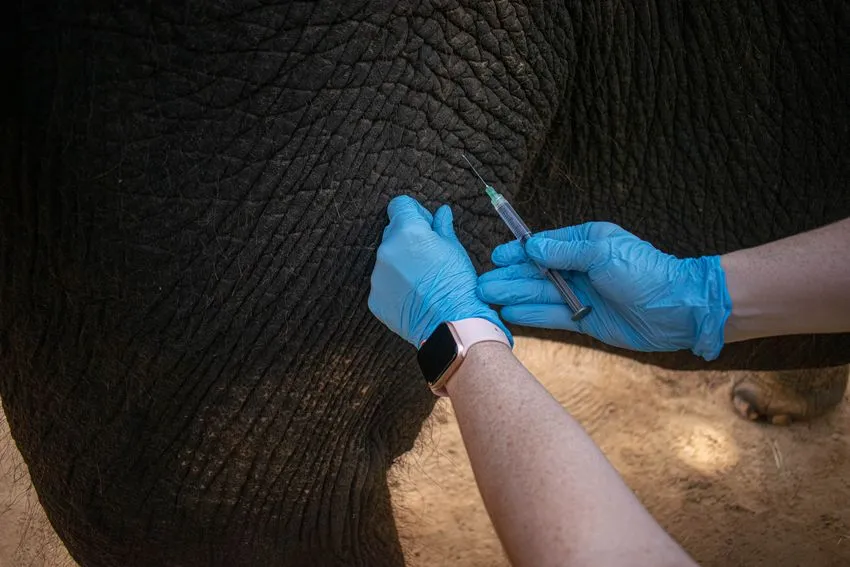In a groundbreaking move for wildlife conservation, the world’s first vaccine designed specifically for Asian elephants has been successfully developed and rolled out. This historic initiative represents hope for one of the planet’s most majestic and endangered species. Asian elephants, whose populations have been steadily declining due to habitat loss, poaching, and disease, now have a powerful new tool to protect them from deadly viral infections.
The vaccine, a product of years of meticulous research and collaboration between veterinary scientists, conservationists, and governments, aims to safeguard these iconic creatures from the elephant endotheliotropic herpesvirus (EEHV), a virus that has been responsible for the deaths of hundreds of young elephants in captivity and the wild.
This article explores the significance of this vaccine, its development journey, the threats facing Asian elephants, and the broader implications for global wildlife conservation.
Table of contents
- 1. Asian Elephants: Majestic Yet Vulnerable
- 2. Understanding Elephant Endotheliotropic Herpesvirus (EEHV)
- 3. The Development Journey of the Vaccine
- 4. Collaboration Across Borders
- 5. The Rollout Strategy
- 6. The Significance for Conservation
- 7. Challenges and Considerations
- 8. Stories of Hope: Saved Lives
- 9. Beyond Vaccination: A Holistic Approach to Conservation
- 10. The Role of Technology in Wildlife Health
- 11. The Global Significance of This Breakthrough
- 12. Ethical Considerations in Wildlife Vaccination
- 13. Community Involvement: Key to Success
- 14. Lessons for Future Wildlife Conservation
- 15. Looking Ahead: A Brighter Future for Asian Elephants
- 16. A Call to Action for Conservation Enthusiasts
- 17. Conclusion: Celebrating a Historic Milestone
1. Asian Elephants: Majestic Yet Vulnerable
Asian elephants (Elephas maximus) are smaller than their African relatives but share the same intelligence, social complexity, and cultural significance. Revered across Asia for centuries, they play a crucial role in ecosystems by dispersing seeds, maintaining forest biodiversity, and supporting the livelihoods of local communities.
Despite their importance, Asian elephants are classified as endangered by the International Union for Conservation of Nature (IUCN). Current estimates suggest that only 40,000–50,000 elephants remain in the wild, fragmented across 13 countries including India, Sri Lanka, Thailand, and Indonesia.
The challenges they face are numerous:
- Habitat Loss: Deforestation, agricultural expansion, and urbanization have reduced natural habitats.
- Human-Elephant Conflict: As elephants venture into farmland, conflicts with humans often lead to injury or death on both sides.
- Poaching: Ivory, skin, and other body parts remain targets for illegal trade.
- Disease: Viral infections, particularly EEHV, pose severe threats, especially to young elephants.
The introduction of a targeted vaccine directly addresses one of the most lethal threats — disease — potentially saving hundreds of lives each year.
2. Understanding Elephant Endotheliotropic Herpesvirus (EEHV)
EEHV is a deadly virus affecting Asian elephants, particularly calves under the age of ten.
- Symptoms: Lethargy, swelling, internal bleeding, and sudden collapse.
- Mortality Rate: Untreated, the virus can kill young elephants within days.
- Prevalence: EEHV has caused significant fatalities in both captive and wild populations, undermining conservation efforts.
Until now, the lack of an effective treatment or preventive measure made EEHV a persistent and devastating threat. Veterinary teams often resorted to supportive care, which had limited success. The development of a vaccine represents the first preventive solution capable of protecting vulnerable populations.
3. The Development Journey of the Vaccine
The journey to develop this vaccine has been a testament to scientific collaboration and persistence.

Key Steps in Development:
- Research Phase: Scientists studied the virus’s genetic structure and mechanisms to identify targets for an effective immune response.
- Laboratory Testing: Candidate vaccines were tested in controlled laboratory settings to evaluate safety and efficacy.
- Clinical Trials: Initial trials in captive elephants involved careful monitoring to ensure no adverse effects while confirming the immune response.
- Regulatory Approval: After extensive review, the vaccine received approval from relevant wildlife and veterinary authorities.
The vaccine uses advanced biotechnology to safely stimulate immunity without causing the disease itself. It is tailored specifically for Asian elephants, ensuring maximum protection while minimizing risks.
4. Collaboration Across Borders
The development and rollout of the elephant vaccine exemplify international cooperation:
- Research Institutions: Leading veterinary universities and biotech labs provided the scientific expertise.
- Wildlife Conservation Organizations: NGOs facilitated field studies, sample collection, and awareness campaigns.
- Governments: Regulatory bodies in India, Thailand, and other range countries ensured the vaccine met safety standards and allocated resources for distribution.
- Zoos and Sanctuaries: Captive elephant populations served as crucial sites for testing and early implementation.
This level of collaboration underscores the global commitment to preserving endangered species and the shared responsibility of protecting wildlife.
5. The Rollout Strategy
The vaccine is being administered in phases to ensure both safety and effectiveness:
- Captive Elephants: Priority is given to young elephants in zoos, sanctuaries, and rehabilitation centers.
- Wild Populations: Targeted vaccination in high-risk habitats, particularly areas where EEHV outbreaks have occurred.
- Monitoring: Post-vaccination surveillance tracks immune responses, potential side effects, and overall health.
The strategy balances immediate protection with long-term conservation goals, aiming to reduce mortality while maintaining natural populations’ genetic diversity.
6. The Significance for Conservation
The impact of this vaccine extends beyond individual elephants:
- Population Stability: By preventing EEHV-related deaths, more calves reach maturity, strengthening population growth.
- Ecosystem Health: Healthy elephant populations maintain forest ecosystems through seed dispersal and landscape management.
- Scientific Advancement: The vaccine sets a precedent for wildlife disease prevention, opening doors for similar initiatives for other endangered species.
- Cultural Preservation: Elephants hold cultural and religious significance across Asia; their survival preserves heritage and traditions.
The vaccine is a concrete step in reversing the decline of a keystone species critical to biodiversity and human culture alike.
7. Challenges and Considerations
While the vaccine is a monumental achievement, challenges remain:
- Logistical Barriers: Administering vaccines to wild elephants in remote forests requires tracking, sedation, and careful handling.
- Cost and Resources: Vaccination programs require sustained funding and personnel training.
- Community Engagement: Local communities must be involved to ensure cooperation and minimize human-elephant conflicts.
- Long-term Monitoring: Continuous research is essential to evaluate immunity duration and potential virus mutations.
Overcoming these challenges will determine the long-term success of this program.
8. Stories of Hope: Saved Lives
Several young elephants have already benefited from the early rollout:
- Rani, a two-year-old elephant in a wildlife sanctuary in India, received the vaccine and showed robust immunity, sparking celebrations among caretakers.
- Milo, a captive elephant in Thailand, survived a prior EEHV outbreak after vaccination, demonstrating the vaccine’s effectiveness in real-world scenarios.
Each success story highlights the life-saving potential of the vaccine and offers hope for the future of the species.
9. Beyond Vaccination: A Holistic Approach to Conservation
While the vaccine addresses disease, comprehensive elephant conservation requires a multi-pronged approach:
- Habitat Protection: Preserving forests and corridors allows elephants to roam safely.
- Anti-Poaching Efforts: Strengthening enforcement and community-based patrols reduces illegal hunting.
- Human-Elephant Conflict Management: Fencing, early warning systems, and community education mitigate conflicts.
- Research and Education: Ongoing studies improve understanding of elephant behavior, ecology, and genetics.
Vaccination is a powerful tool, but it is most effective when combined with broader conservation strategies.
10. The Role of Technology in Wildlife Health
Modern technology has played a key role in both developing and administering the elephant vaccine:

- Genomic Sequencing: Allowed scientists to study EEHV’s structure and identify targets for immunity.
- Tracking Devices: GPS collars help locate wild elephants for vaccination and monitoring.
- Telemedicine: Remote health monitoring enables rapid response to illness or injury.
- Data Analytics: Large datasets track vaccination outcomes and guide conservation policies.
By integrating science and technology, conservationists can safeguard elephants more effectively than ever before.
11. The Global Significance of This Breakthrough
The successful development of an elephant-specific vaccine is not just a regional victory — it’s a global milestone:
- Demonstrates that proactive disease prevention is possible in wildlife populations.
- Serves as a model for endangered species conservation worldwide.
- Highlights the importance of investing in veterinary science and biotechnology for conservation.
- Inspires hope for other species threatened by infectious diseases, such as rhinos and big cats.
This initiative proves that science, when combined with compassion and strategic planning, can alter the trajectory of endangered species recovery.
12. Ethical Considerations in Wildlife Vaccination
While life-saving, wildlife vaccination programs must consider ethical concerns:
- Interference with Natural Processes: Some argue that humans should not intervene in nature. However, human-driven habitat loss and poaching justify proactive measures.
- Animal Stress: Capturing and vaccinating elephants must be done with minimal distress and professional care.
- Resource Allocation: Ensuring equitable distribution of resources without neglecting other species is crucial.
Conservationists emphasize that ethical, well-planned vaccination programs complement rather than replace broader ecosystem management.
13. Community Involvement: Key to Success
Local communities are vital allies in the vaccination program:
- Awareness Campaigns: Educating communities about EEHV and the vaccine encourages support.
- Employment Opportunities: Community members assist with monitoring and care, creating economic incentives.
- Conflict Mitigation: Engaged communities help prevent accidental injuries to elephants and humans.
Conservation is most effective when it balances animal protection with human well-being.
14. Lessons for Future Wildlife Conservation
The rollout of the elephant vaccine offers valuable lessons for global wildlife protection:
- Proactive Disease Prevention: Vaccination can prevent population collapse in endangered species.
- Cross-Sector Collaboration: Governments, NGOs, researchers, and communities must work together.
- Long-Term Monitoring: Continuous data collection ensures program effectiveness.
- Adaptive Management: Conservation strategies must evolve with emerging threats and scientific discoveries.
These lessons can guide efforts to save other species facing similar existential threats.
15. Looking Ahead: A Brighter Future for Asian Elephants
With the vaccine in place, conservationists are cautiously optimistic. Success will depend on sustained funding, continued research, and global support.
Key goals moving forward include:
- Expanding vaccination to all high-risk populations.
- Integrating vaccination programs with anti-poaching and habitat restoration efforts.
- Encouraging governments and international organizations to support similar initiatives.
- Sharing knowledge globally to protect other endangered wildlife species.
This proactive approach could change the narrative for Asian elephants from decline to recovery.
16. A Call to Action for Conservation Enthusiasts
Every individual can contribute to the survival of Asian elephants:
- Support wildlife charities and sanctuaries financially or through volunteering.
- Advocate for policies that protect elephant habitats and combat poaching.
- Educate others about threats facing elephants and the importance of vaccination programs.
- Reduce environmental footprints by promoting sustainable practices.
Conservation is a collective effort — small actions, multiplied globally, can save species from extinction.
17. Conclusion: Celebrating a Historic Milestone
The rollout of the world’s first elephant-specific vaccine marks a historic milestone in conservation. It embodies the power of science, collaboration, and determination to protect one of the planet’s most iconic species.
Asian elephants are more than wildlife; they are keystone species, cultural symbols, and living reminders of the natural wonders our world holds. By safeguarding them from deadly diseases, humanity reaffirms its commitment to preserving biodiversity for future generations.
While challenges remain, the vaccine offers hope — a tangible tool that complements broader conservation efforts. It reminds us that through innovation, compassion, and conscious action, we can change the fate of endangered species.
Every vaccination is not just a shot in the arm — it’s a lifeline, a promise, and a step toward a future where Asian elephants roam freely, healthy and safe, across their ancestral lands.
